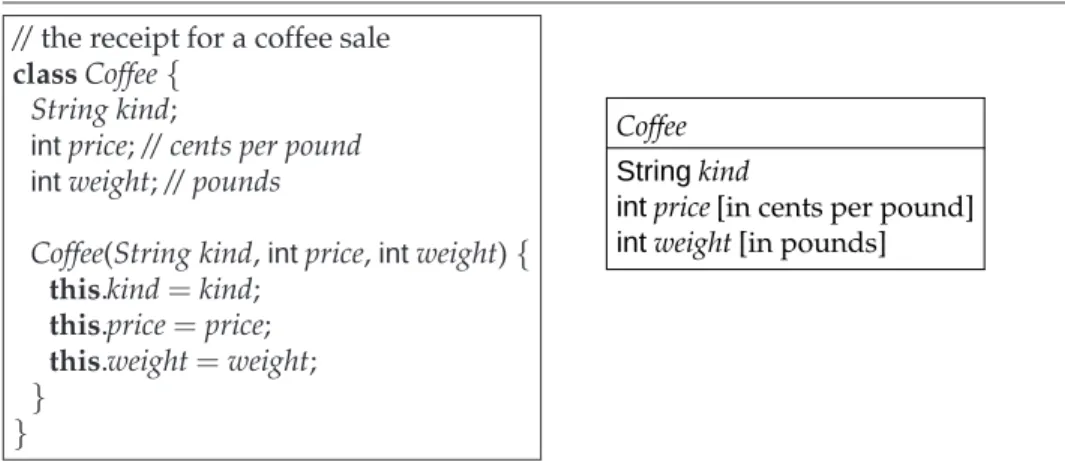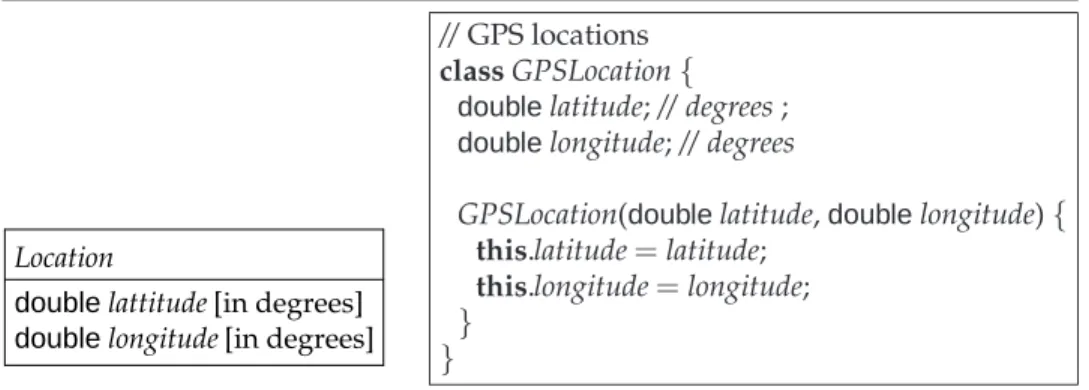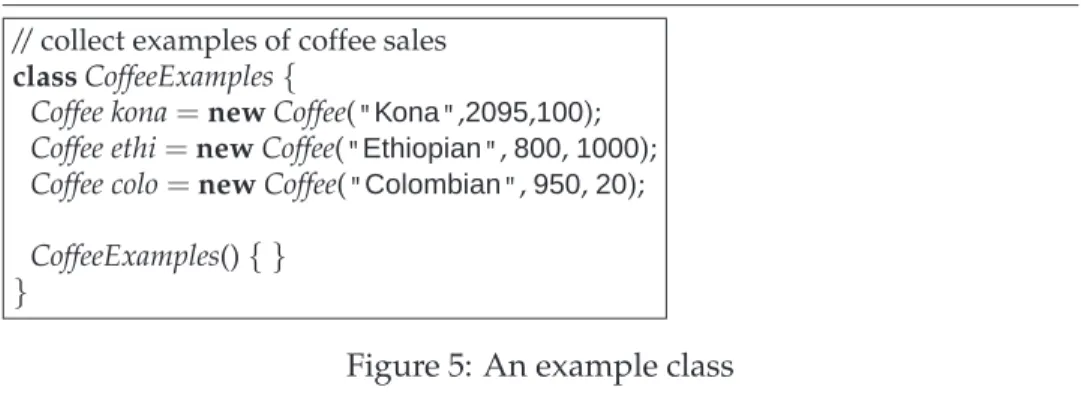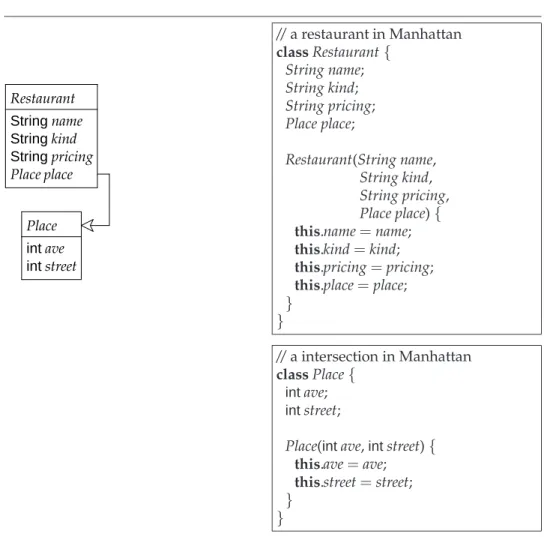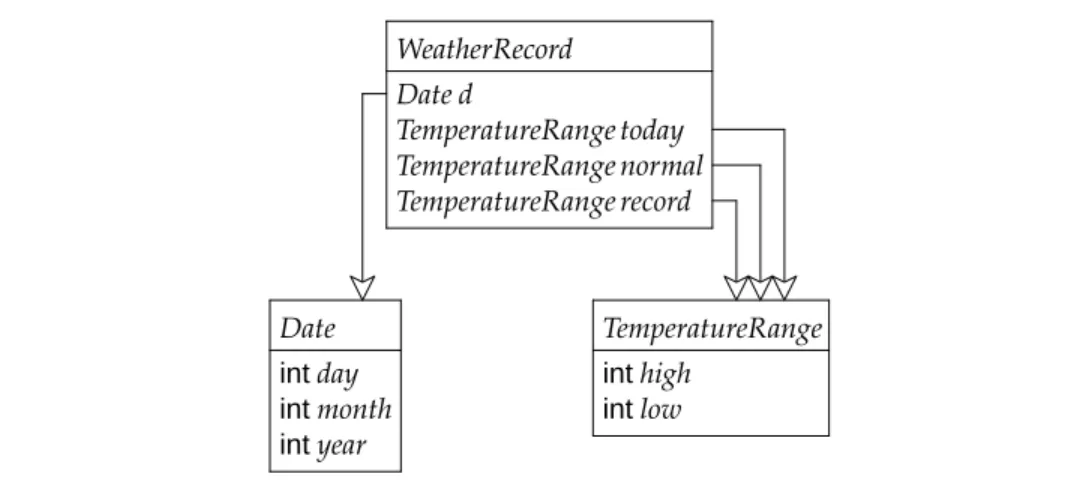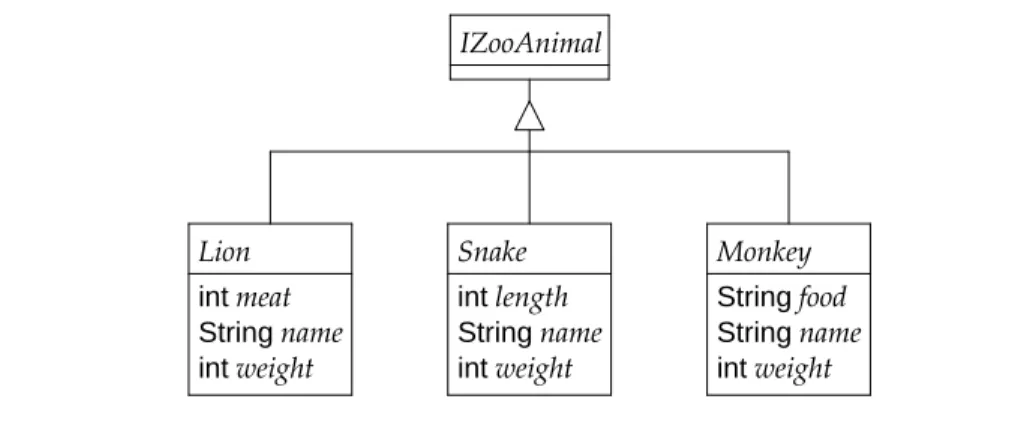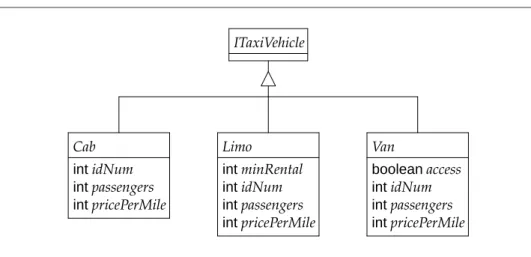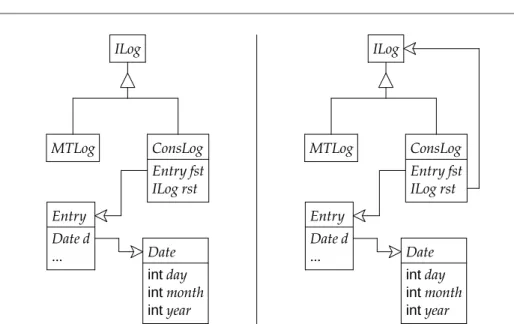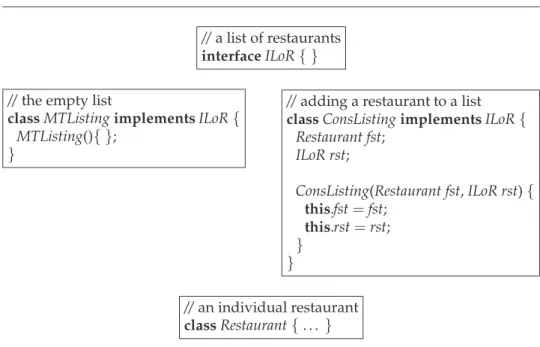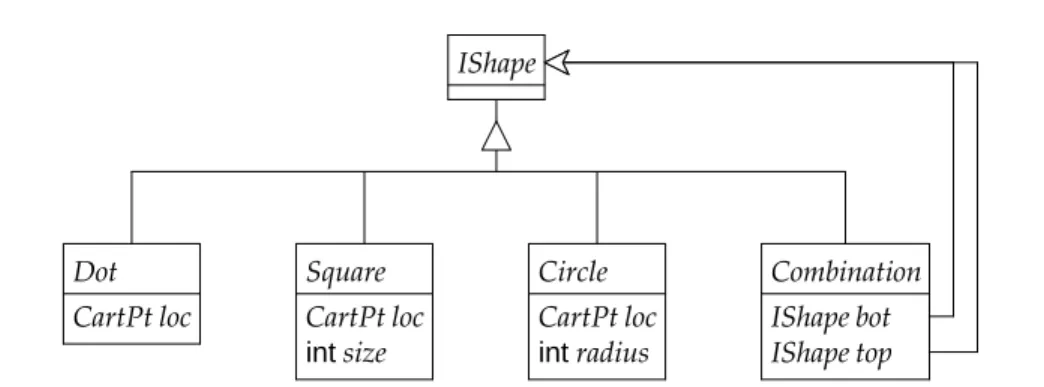Data: Structure and Organization
Matthias Felleisen
Matthew Flatt
Robert Bruce Findler
Kathryn E. Gray
How to design class: object-oriented programming and computing Matthias Felleisen, Matthew Flatt, Robert Bruce Findler, Kathryn E. Gray, Shriram Krishnamurthi, Viera K. Proulx
p. cm. Includes index.
ISBN 0-262-06218-6 (hc.: alk. paper)
1. Computer Programming. 2. Electronic data processing. QA76.6 .H697 2001
Contents
Preface xii
Acknowledgements . . . xiii
I The Varieties of Data 7
1 Primitive Forms of Data 8
2 Classes 9
2.1 Finger Exercises on Plain Classes . . . 15 2.2 Designing Classes . . . 18 3 Class References, Object Containment 19 3.1 Finger Exercises on Object Containment . . . 25 3.2 Designing Classes that Refer to Classes . . . 26
4 Unions of Classes 27
4.1 Types vs Classes . . . 30 4.2 Finger Exercises on Unions . . . 32 4.3 Designing Unions of Classes . . . 35 5 Unions, Self-References and Mutual References 37 5.1 Containment in Unions, Part 1 . . . 37 5.2 Containment in Unions, Part 2 . . . 44 5.3 Finger Exercises on Containment in Unions . . . 49
6 Designing Class Hierarchies 50
6.1 Exercises . . . 54 6.2 Case Study: Fighting UFOs . . . 56
Intermezzo 1: Classes and Interfaces 64
Vocabulary and Grammar . . . 64 Meaning . . . 67 Syntax Errors, Type Errors, and Run-time Errors . . . 69
8 Expressions 1, Computing with Primitive Types 83
9 Expressions 2, Method Calls 85
10 Methods for Classes 87
10.1 Designs through Templates . . . 87
10.2 Finger Exercises . . . 93
10.3 Designing Methods for Classes . . . 95
10.4 Conditional Computations . . . 96
10.5 Composing methods . . . 104
11 Methods and Object Containment 107 11.1 Finger Exercises . . . 113
11.2 Designing Methods for Classes that Contain Classes . . . 113
12 Methods and Unions of Classes 114 12.1 Example: Plain Geometric Shapes . . . 115
12.2 Signaling Errors . . . 127
13 Types, Classes, and How Method Calls Compute 128 13.1 Method Dispatch . . . 128
13.2 The Role of Types . . . 132
14 Methods and Unions of Classes (Continued) 135 14.1 How Libraries Work, Part 1: Drawing Geometric Shapes . . 135
14.2 Finger Exercises . . . 140
14.3 Designing Methods for Unions of Classes . . . 142
15 Methods and Classes with Mutual References 142 15.1 Example: Managing a Runner’s Logs . . . 142
15.2 Example: Sorting . . . 150
15.3 Example: Overlapping Shapes . . . 153
15.4 Example: River Systems . . . 163
15.5 Finger Exercises . . . 171
16 Designing Methods 173 16.1 The Varieties of Templates . . . 174
16.2 Wish Lists . . . 178
Intermezzo 2: Methods 194
Vocabulary and Grammar for Methods . . . 195
Type Checking . . . 197
Meaning: Evaluating Method Calls . . . 202
Syntax Errors, Type Errors, and Run-time Errors . . . 212
III Abstracting with Classes 221 18 Similarities in Classes 222 18.1 Common Fields, Superclasses . . . 222
18.2 Abstract Classes, Abstract Methods . . . 226
18.3 Lifting Methods, Inheriting Methods . . . 228
18.4 Creating a Superclass, Creating a Union . . . 234
18.5 Deriving Subclasses . . . 250
19 Designing Class Hierarchies with Methods 251 19.1 Local Variables and Composition . . . 252
19.2 Abstracting with Methods . . . 255
19.3 Abstracting within Unions of Classes . . . 258
19.4 Abstracting through the Creation of Unions . . . 261
19.5 Deriving Subclasses from “Library” Classes . . . 265
19.6 Creating Subclasses for Special Objects . . . 267
19.7 How Libraries Work, Part 2: Deriving Classes . . . 272
19.8 Case Study: Fighting UFOs, All the Way . . . 277
19.9 Mini Project: Worm . . . 287
20 State Encapsulation and Self-Preservation 291 20.1 The Power of Constructors . . . 292
20.2 Overloading Constructors . . . 296
20.3 Encapsulating and Privacy . . . 298
20.4 Guidelines for State Encapsulation . . . 304
20.5 Finger Exercises on Encapsulation . . . 305
21 Extensional Equality, Part 1 308 21.1 Equality for Plain Classes . . . 308
21.2 Equality for Inheritance . . . 313
Intermezzo 3: Abstract Classes, Privacy 322
Abstract Classes and Class Extensions . . . 322
Privacy for Methods . . . 323
Overloading Constructors and Methods . . . 323
IV Circular Objects, Imperative Methods 327 23 Circular Data 328 23.1 Designing Classes for Circular Objects, Constructors . . . 337
23.2 The True Nature of Constructors . . . 340
23.3 Circularity and Encapsulation . . . 340
23.4 Example: Family Trees . . . 343
24 Methods on Circular Data 348 25 The State of the World and How It Changes 359 26 Assignments and Changes in the World 361 26.1 Example: Dropping Blocks . . . 362
26.2 Example: Accounts . . . 364
26.3 How Libraries Work 3: An Alternative World . . . 367
27 Designing Stateful Classes, Imperative Methods 373 27.1 When to Use Stateful Classes and Imperative Methods . . . 375
27.2 How to Design Stateful Classes, Imperative Methods . . . . 378
27.3 Imperative Methods and Templates . . . 384
27.4 Imperative Methods and Abstraction . . . 387
27.5 Danger! . . . 389
27.6 Case Study: More on Bank Accounts . . . 395
27.7 Case Study Repeated: A Stateful Approach to UFOs . . . 399
27.8 Case Study: A Deck of Cards . . . 408
27.8.1 Caching and Invisible Assignments . . . 418
27.8.2 Merging List Traversals: Splitting Lists . . . 420
27.9 Endnote: Where do Worlds Come from? Where do they go? 423 28 Equality 434 28.1 Extensional Equality, Part 2 . . . 435
28.2 Intensional Equality . . . 435
28.3 Extensional Equality withnull . . . 440
28.5 Danger! Extensional Equality and Cycles . . . 443
Intermezzo 4: Assignments 449 V Abstracting Data Representations 452 30 Types and Similarities between Plain Classes 452 30.1 Classes with Common Structure, Different Types . . . 453
30.2 Abstracting Types via Subtyping . . . 454
30.3 Abstracting Types via Generics . . . 457
31 Types and Similarities between Hierarchies 464 31.1 Abstracting Types via Subtyping, Part 2 . . . 465
31.2 Abstracting Types via Subtyping plus Interfaces . . . 471
31.3 Abstracting Types via Generics, Part 2 . . . 476
31.4 Abstracting Types via Generics plus Interfaces . . . 479
32 Designing General Classes and Frameworks 484 32.1 Subtyping Summarized . . . 488
32.2 Generalizing via Subtyping . . . 490
32.3 Generalizing via Generics . . . 500
32.4 Finger Exercises: Sets, Stacks, Queues, and Trees Again . . . 503
32.5 Errors, also known as Runtime Exceptions . . . 508
33 Designing (to) Interfaces 511 33.1 Organizing Programs, Hiding Auxiliary Methods . . . 511
33.2 Getters, Predicates, and Setters . . . 517
33.3 Interfaces as Specifications . . . 520
34 Extensible Frameworks: Abstracting Constructors 526 34.1 Data Extensions are Easy . . . 528
34.2 Function Extension: A Design that doesn’t Quite Work . . . . 531
34.3 . . . and how to Fix it (Mostly) . . . 535
34.4 Function Extension: Take 2 . . . 540
34.5 Mini Project: The Towers of Hanoi . . . 544
VI Abstracting Data Traversals 551
36 Patterns in Traversals 551
36.1 Example: Menus Designed from Scratch . . . 553
36.2 Example: Menus Designed as Lists . . . 554
36.3 Methods as Objects . . . 556
36.4 List Traversals and Polymorphic Methods . . . 561
36.5 Example:fold. . . 569
36.6 Example: Arithmetic Expressions and Traversals . . . 575
37 Designing Abstract Traversal Methods 587 37.1 Methods as Objects via Subtyping . . . 587
37.2 Methods as Objects via Generics . . . 590
37.3 Abstracting over Method Calls, Anonymous Inner Classes . 591 37.4 Inner Classes, Anonymous Classes . . . 594
37.5 Visitor Traversals and Designing Visitors . . . 596
37.6 Finger Exercises: Visiting Lists, Trees, Sets . . . 608
37.7 Extended Exercise: Graphs and Visitors . . . 610
37.8 Where to Use Traversals, or Aggregation . . . 613
37.9 Object-Oriented and Functional Programming . . . 617
38 Traversing with Effects 619 38.1 Abstracting over Imperative Traversals: theforEachMethod 619 38.2 Using theforEachMethod . . . 621
38.3 UsingforEachwith Anonymous Classes . . . 626
38.4 Mini Projects, including a Final Look at “War of the Worlds” 631 38.5 Abusing theforEachMethod . . . 635
39 Extensible Frameworks with Visitors 642 Intermezzo 6: Generic Methods, Inner Classes 643 VII Loops and Arrays 645 41 The Design Flaw 645 42 Loops 645 42.1 Designing Loops . . . 645
42.3 Why Loops are Bad . . . 646
43 From Design to Loops 646
44 ArrayLists 646
Intermezzo 7: Loops 647
VIII Java 649
46 Some Java Linguistics 649
47 Some Java Libraries 649
48 Java User Interfaces 649
48.1 Scanning and parsing . . . 649 48.2 Graphical User Interfaces . . . 649
The goals were to provide modules and to eliminate as-signment altogether.
—Alan Kay,History of Smalltalk Diagrams
Draw them by hand. Diagrams are the programmer’s doodling lan-guage. Using a tool that draws them for you from the existing code defeats the purpose. Assigning students to do so defeats the purpose of learning to doodle.
Stuff
Conventional text books at this level present object-oriented program-ming as an extension of imperative programprogram-ming. The reasoning is that computations interact with the real world where physical objects change their state all the time. For example, people get sick and become patients; balls drop from a hand and change location; and so on. Therefore, the rea-soning goes, computational objects, which represent physical objects, en-capsulate and hide the state of the world for which they are responsible and, on method calls, they change state. Naturally, people begin to express computations as sequences of assignment statements that change the value of variables and fields (instance variables).
We disagree with this perspective and put classes and the design of classes into the center of our approach. In “How to Design Programs” we defined classes of data. As we developed larger and larger programs, it be-came clear that the design of a program requires the introduction of many classes of data and the development of several functions for each class. The rest is figuring out how the classes of data and their functions related to each other.
What you will learn What you won’t learn Java.
It is a good idea to study the programming language that you use on a daily basis and to learn as much as possible about it. We strongly believe, however, that it is a bad idea to teach the details of any programming lan-guage in a course. Nobody can predict which programming lanlan-guage you will use. Therefore, time in a course is better spent on studying the general principles of program design rather than the arcane principles of any given programming language.
Why Java? Why ProfessorJ?
ProfessorJ is not Java; it is a collection of relatively small, object-oriented programming languages made up for teaching the design of classes, i.e., the essence of object-oriented programming. For the most part, they are subsets of Java but, to support the pedagogy of this book, they also come with constructs for playing with examples and testing methods.
ProfessorJ is useful for the first four chapters. After that, it is essential that you switch to a full-fledged programming language and an industrial programming environment. This may mean switching to something like Java with Eclipse or C# with Microsoft’s Visual Studio.
Acknowledgments
Daniel P. Friedman, for asking the first author to co-authorA Little Java, A Few Patterns(also MIT Press);
Purpose and Background
The goal of this chapter is to develop data modeling skills.
We assume that students have understood data definitions in Parts I, II, and III ofHow to Design Programs. That is, they should understand what it means to represent atomic information (numbers, strings), compounds of information (structures), unions of information (unions), and information of arbitrary size (lists, trees); ideally students should also understand that a program may rely on an entire system of interconnected data definitions (family trees, files and folders).
TODO
— add examples that initialize fields between sections 1 and LAST
— add exercises that ask students to represent something with classes that isn’t completely representable; they need to recognize what to omit when going from information to data. do it early in the chapter.
— add modeling exercise to Intermezzo 1 that guides students through the process of modeling Java syntax (information) via Java classes (data) start with an exercise that says
class ClassRep String name; ClassRep(String name) this. name = name;
InHow to Design Programs, we learned that the systematic design of a pro-gram requires a solid understanding of the problem information. The first step of the design process is therefore a thorough reading of the problem statement, with the goal of identifying the information that the requested program is given and the information that it is to compute. The next step is to represent this information as data in the chosen programming language. More precisely, the programmer must describe the classes of all possible input data and all output data for the program. Then, and only then, it is time to design the program itself.
ProfessorJ: Beginner Thus, when you encounter a new programming language, your first
goal is to find out how to represent information in this language. InHow to Design Programsyou used an informal mixture of English and Scheme con-structors. This book introduces one of the currently popular alternatives: programming in languages with a notation for describing classes of data within the program. Here the word “class” is short for “collection” in the spirit in which we used the word inHow to Design Programs; the difference is that the designers of such languages have replaced “data” with “object,” and that is why these languages are dubbed object-oriented.
1
Primitive Forms of Data
Like Scheme, Java provides a number of built-in atomic forms of data with which we represent primitive forms of information. Here we use four of them:int,double,boolean, andString.1
How to Design Programsusesnumberto represent numbers in the prob-lem domain. For integers and rational numbers (fractions or numbers with a decimal point), these representations are exact. When we use Java—and most other programming languages—we give up even that much preci-sion. For example, while Java’sint is short for integer, it doesn’t truly in-clude all integers—not even up to the size of a computer. Instead, it means the numbers
from −2147483648 to 2147483647 .
If an addition of two ints produces something that exceeds 2147483647, Java finds agood enough2number in the specified range to represent the
re-sult. Still, for our purposes,intis often reasonable for representing integers. In addition to exact integers, fractions, and decimals,How to Design Pro-gramsalso introduced inexact numbers. For example, the square root func-tion (sqrt) produces an inexact number when given2. For Java and similar languages,double is a discrete collection of rational numbers but is used to represent the real numbers. That is, it is roughly like a large portion of the real number line but with large gaps. If some computation with real numbers produces a number that is in the gap between twodoubles, Java somehow determines which of the two is agood enough approximation to the result and takes it. For that reason, computations withdoubles are in-herently inaccurate, but again, for our purposes we can think ofdoubles as a strange form of real numbers. Over time, you will learn when to useints and when to usedoubles to represent numeric information.
As always, thebooleanvalues aretrueandfalse. We use them to repre-senton/off information,absence/presenceinformation, and so on.
Finally, we useStrings to represent symbolic information in Java. Sym-bolic information means the names of people, street addresses, pieces of conversations, and similarly symbolic information. For now, aStringis a sequence of keyboard characters enclosed in quotation marks; e.g.,
1For Java,Stringvalues are really quite different fromintegers orbooleans. We ignore the difference for now.
"bob" "#$%ˆ&" "Hello World" "How are U?"
"It is 2 good to B true."
Naturally, a string may not include a quotation mark, though there are ways to produceStrings that contain this character, too.
2
Classes
For many programming problems, we need more than atomic forms of data to represent the relevant information. Consider the following problem:
. . . Develop a program that keeps track of coffee sales at a spe-cialty coffee seller. The sales receipt must include the kind of coffee, its price (per pound), and its weight (in pounds). . . .
The program may have to deal with hundreds and thousands of sales. Un-less a programmer keeps all the information about a coffee sale together in one place, it is easy to lose track of the various pieces. More generally, there are many occasions when a programmer must represent several pieces of information that always go together.
Our sample problem suggests that the information for a coffee sale con-sists of three (relevant) pieces: the kind of coffee, its price, and its weight. For example, the seller may have sold
1. 100 pounds of Hawaiian Kona at $20.95/pound; 2. 1,000 pounds of Ethiopian coffee at $8.00/pound; and 3. 1,700 pounds of Colombian Supreme at $9.50/pound.
InHow to Design Programs, we would have used a class of structures to represent such coffee sales:
(define-structcoffee(kind price weight)) ;;Coffee(sale) is:
;; — (make-coffee String Number Number)
functions coffee-kind, coffee-price, and coffee-weight. The second and third line tells us how to use this constructor; it is applied to a string and two numbers:
(make-coffee"Hawaiian Kona"20.95 100) (make-coffee"Ethiopian"8.00 1000)
(make-coffee"Colombian Supreme"9.50 1)
Note the use of ordinary numbers, which in Beginning Student Scheme denote precisely the decimal numbers written down.
In Java, we define theCLASS in figure 1 for the same purpose. The left column of the figure shows what such a class definition looks like. The first line is a Java-style end-of-line comment, spanning the rest of the line; the slashes are analogous to “;;” in Scheme. The second line
classCoffee{
announces a class definition. The name of the class isCoffee. The opening brace “{” introduces the items that belong to the class. The next three lines
String kind;
intprice;// cents per pound intweight;// pounds
state that an element of theCoffee class (think collection for the moment) has threeFIELDs. Their names arekind, price, andweight. The left of each field declaration specifies the type of values that the field name represents. Accordingly,kindstands for aStringandpriceandweightareints.
The two lines forpriceandweightdefinitions end with comments, indi-cating which monetary and physical units that we use forpriceandweight. Valuating prices in integer cents is good practice because Java’s calculations on integers are accurate as long as we know that the numbers stay in the proper interval.3
The next four lines inCoffeedefine theCONSTRUCTORof the class: Coffee(String kind,intprice,intweight){
this.kind=kind; this.price=price; this.weight=weight; }
//the receipt for a coffee sale
classCoffee{ String kind;
intprice;// cents per pound
intweight;// pounds
Coffee(String kind,intprice,intweight){
this.kind=kind;
this.price=price;
this.weight=weight;
} }
Coffee String kind
intprice [in cents per pound] intweight [in pounds]
Figure 1: A class definition and a class diagram
Unlike Scheme, Java doesn’t define this constructor automatically. Instead, the programmer must add one manually. For now, we use the following “cookie-cutter” approach to defining constructors:
1. A constructor’s body starts with an opening brace ({).
2. The parameters of a constructor look like the fields, separated by commas (“,”).
3. Its body is a semicolon-separated (“;”) series of “equations” of the shape4 “this.fieldname = fieldname;” and there are as many “equa-tions” as fields.
4. The last line of a constructor body is a closing brace (}).
The last line of the class definition is}, closing off the class definition. Even though a Java data representation looks more complex now than a corresponding Scheme data definition, the two are actually equivalent. In How to Design Programs, we used a structure definitionwitha data definition to describe (in code and in English) how a piece of data represents some in-formation. Here we combine the two into a single class definition. The only extra work is the explicit definition of the constructor, whichdefine-struct introduces automatically. Can you think of situations when the ability to define your own constructor increases your programming powers?
After we have defined a class, it is best to translate some sample pieces of information into the chosen representation. This tests whether the de-fined class is adequate for representing some typical problem information and, later on, we can use these examples to test our program(s). For exam-ple, to create an object of theCoffeeclass, you apply the constructor to as many values as there are parameters:
newCoffee("Hawaiian Kona",2095,100)
The notation differs a bit from Scheme; here the three values are enclosed in parentheses and separated by commas.5
The application of the constructor creates anINSTANCE—also known as anOBJECT—of theCoffeeclass. Here we obtain the first sample of informa-tion for our problem, that is, the sale of 100 pounds of Kona for US c 2095 per pound. The other two samples have similar translations:
newCoffee("Ethiopian",800,1000) and
newCoffee("Colombia Supreme",950,1)
Finally, before we move on to a second example, take a look at the right side of figure 1. It is a pictorial illustration of theCoffeeclass, which is useful because of the notational overhead for Java’s class definition. The rectan-gle has two pieces. The upper portion names the class; the lower portion lists the fields and their type attributes. This picture is called aCLASS DI -AGRAM.6 These diagrams are particularly useful while you analyze prob-lems and for discussions on how to represent information as data. You will encounter many of them in this book.
Here is another excerpt from a typical programming problem: . . . Develop a program that helps you keep track ofdaily. . .
The word “daily” implies you are working with many dates. One date is described with three pieces of information: a day, a month, and a year.
In Java, we need a class with three fields. We name the classDateand the fieldsday,month, andyear. Usingints to count days, months, and years is natural, because that’s what people do. This suggests the class diagram and the class definition in figure 2.
Let’s look at some instances ofDate:
Date intday intmonth intyear
//calendar dates
classDate{
intday; intmonth; intyear;
Date(intday,intmonth,intyear){
this.day=day;
this.month=month;
this.year=year;
} }
Figure 2: Representing dates
1. newDate(5,6,2003) stands for June 5, 2003; 2. newDate(6,6,2003) stands for June 6, 2003; and 3. newDate(23,6,2000) stands for June 23, 2000.
Of course, we can also writenewDate(45,77,2003). This expression creates an instance ofDate, but not one that corresponds to a true calendar date.7
Let’s take a look at a third problem statement:
. . . Develop a GPS-based navigation program for cars. The GPS device feeds the program with the current location at least once a second. The location is given as latitude and longitude. Examples:
1. latitude 33.5, longitude 86.8; 2. latitude 40.2, longitude 72.4; and 3. latitude 49.0, longitude 110.3. . . .
The relevant information is a called a GPS location.
Location
double lattitude [in degrees] doublelongitude [in degrees]
//GPS locations
classGPSLocation{
doublelatitude;// degrees;
doublelongitude;// degrees
GPSLocation(doublelatitude,doublelongitude){
this.latitude=latitude;
this.longitude=longitude;
} }
Figure 3: Representing navigations in a GPS
A class for GPS locations needs two fields: one for latitude and one for longitude. Since both are decimal numbers that are approximate anyway, we usedoubles to represent them. Figure 3 contains both the class diagram and the class definition. As for turning data into information (and vice versa) in this context, see exercise 2.1.
Ball intx inty int RADIUS
//moving balls on a pool table
classBall{
intx; inty;
intRADIUS=5;
Ball(intx,inty){
this.x=x;
this.y=y;
} }
Figure 4: Representing pool balls
Now the radius of these balls is going to stay the same throughout the simulation, while their coordinates constantly change. To express this dis-tinction and to simplify the creation of instances ofBall, a programmer adds an initialization “equation” directly to a field declaration: seeRADIUSin figure 4. By convention, we use uppercase letters for the names of fields to indicate that they are constant, shared attributes.
If a field comes with an initialization “equation”, the constructor does notcontain an equation for that field. Thus, theBallconstructor consumes two values, xandy, and contains two “equations:” one forxand one for y. To create instances of Ball, you can now write expressions such asnew
Ball(10,20), which produces an object with three attributes: x with value 10;ywith value20; andRADIUSwith value5. Explore the creation of such objects in the interactions window.
//collect examples of coffee sales
classCoffeeExamples{
Coffee kona=newCoffee("Kona",2095,100);
Coffee ethi=newCoffee("Ethiopian",800,1000);
Coffee colo=newCoffee("Colombian",950,20);
CoffeeExamples(){ } }
Figure 5: An example class
ProfessorJ: Examples Before moving on, let’s briefly turn to the administration of examples.
A good way to keep track of examples is to create a separate class for them. For example, figure 5 shows how to collect all the sample instances ofCoffee in a singleExamplesclass. As you can see, all fields are immediately initial-ized via “equations” and the constructor has neither parameters nor con-structor “equations.” Creating an instance of theCoffeeExamples class also creates three instances of the Coffee class, which ProfessorJ’s interactions window visualizes immediately so that you can inspect them. Of course, such example classes thus introduce a concept that we haven’t covered yet: objects that contain objects. The next section is all about this idea.
2.1 Finger Exercises on Plain Classes
What is the meaning ofnewGPSLocation(42.34,71.09) in this context? Why does this question (as posed) not make any sense?
If we tell you that the first number is associated with north and the second one with west, can you make sense out of the question? Can you find this place on a globe? On a map of the USA?
Exercise 2.2 Take a look at this problem statement:
. . . Develop a program that assists bookstore employees. For each book, the program should track the book’s title, its price, its year of publication, and the author’s name. . . .
Develop an appropriate class diagram (by hand) and implement it with a class. Create instances of the class to represent these three books:
1. Daniel Defoe,Robinson Crusoe, $15.50, 1719; 2. Joseph Conrad,Heart of Darkness, $12.80, 1902; 3. Pat Conroy,Beach Music, $9.50, 1996.
What doesnewBook("D. P. Friedman","The Little LISPer",900,1974) mean? Does the question make sense? What do you need to know to interpret this piece of data?
Exercise 2.3 Add a constructor to the following partial class definition and draw the class diagram (by hand):
//represent computer images classImage{
intheight;// pixels intwidth;// pixels
String source;// file name String quality;// informal . . .
}
Explain what the expressions mean in the problem context: newImage(5,10,"small.gif","low")
newImage(120,200,"med.gif","low")
newImage(1200,1000,"large.gif","high") .
Suppose the web designer decides that theImageclass should also spec-ify to which gallery the images belong so that functions for this class of data have the information handy. Modify the class definition appropriately. As-sume that the gallery is the same for all instances ofImage.
Automobile Stringmodel int price [in dollars]
doublemileage [in miles per gallon] booleanused
Figure 6: A class diagram for automobiles
Exercise 2.4 Translate the class diagram in figure 6 into a class definition. Also create instances of the class.
Exercise 2.5 Create three instances of the following class: //introducing the concept of gravity
classApple{ intx;
inty;
intRADIUS=5;
intG=10;// meters per second square Apple(intx,inty){
this.x=x; this.y=y; }
}
2.2 Designing Classes
This first section on classes suggests that the design of a class proceeds in three steps:
1. Read the problem statement. Look for statements that mention or list the attributes of the objects in your problem space. This tells you how many fields you need for the class definition and what information they represent. Write down your findings as a class diagram because they provide a quick overview of classes, especially when you are dealing with many classes or when you return to the problem in a few months from now.
2. Translate the class diagram into a class definition, adding a purpose statement to each class. The purpose statement should explain what information the instance of the class represent (and how).
This translation is mostly mechanical. Only one part needs your full attention: the decision whether a field should have the same value for allinstances of this class. If so, use an initialization equation with the field; otherwise, add the field as a parameter to the constructor and add an equation of the shapethis.field=fieldto the constructor.
3. Obtain examples of information and represent them with instances of the class. Conversely, make up instances of the class and interpret them as information.
Warning: Keep in class that some data examples have no explanation in the problem space. You may wish to warn future readers of your code about such instances with a comment.
3
Class References, Object Containment
What we have seen so far is that a class in Java is somewhat like a structure in Scheme. Each instance compounds several pieces of data into one. Your experience—both in programming and in the real world—should tell you that this kind of compounding can happen at several levels, that is, a piece of information may contain some other piece of information that consists of many pieces of information and so on. Let’s look at an example:
. . . Develop a program that manages a runner’s training log. Every day the runner enters one entry about the day’s run. Each entry includes the day’s date, the distance of the day’s run, the duration of the run, and a comment describing the runner’s post-run disposition. . . .
Clearly, a log entry consists of four pieces of information: a date, a distance, a duration, and a comment. To represent the last three, we can use Java’s primitive types:double(for miles),int(for minutes), andString. As we have seen in section 2, however, the natural representation for dates consists of three pieces; it is not a basic type.
Let’s make up some examples before we formulate a data definition: on June 5, 2003 5.3 miles 27 minutes feeling good
on June 6, 2003 2.8 miles 24 minutes feeling tired on June 23, 2003 26.2 miles 150 minutes feeling exhausted
. . . .
The three recordings are from three distinct dates, with widely varying mileage and post-practice feelings.
If we were to represent these forms of data in Scheme we would formu-late two structure definitions and two data definitions:
(define-structentry(date distance duration comment)) ;;Entryis:
;; — (make-entry Date Number Number String) (define-structdate(day month year))
;;Dateis:
;; — (make-date Number Number Number)
Entry Dated
doubledistance [in miles] intduration [in minutes] String comment
Date int day intmonth intyear
//an entry in a runner’s log
classEntry{ Date d;
doubledistance;// miles
intduration;// minutes String comment;
Entry(Date d,
doubledistance,
intduration,
String comment){
this.d=d;
this.distance=distance;
this.duration=duration;
this.comment=comment;
} }
//calendar dates
classDate{
intday; intmonth; intyear;
Date(intday,intmonth,intyear){
this.day=day;
this.month=month;
this.year=year;
} }
Figure 7: Representing a runner’s log
Using these data definitions as guides for making up data, translating the three examples into Scheme data is straightforward:
(make-entry(make-date5 6 2003)5.3 27"Good") (make-entry(make-date6 6 2003)2.8 24"Tired")
(make-entry(make-date23 6 2003)26.2 150"Exhausted")
(defined1(make-date5 6 2003))
(definee1(make-entry d15.3 27"Good"))
For practice, construct the last two examples in the same fashion.
We already know how to express the data definition for Dates with a class diagram. It is just a rectangle whose name portion isDateand whose field portion contains three pieces: one for the day, one for the month, and one for the year.
The diagram forEntrys is—in principle—also just a box. The field por-tion contains four pieces: one for Date, one for the miles, one for the min-utes, and one for the post-run condition. The difference betweenEntryand classes such asDateor GPSLocationis that the type of the first field is not a primitive Java type but another class. In the case of Entry, it isDate. In class diagrams we explicate this relationship with a CONTAINMENT AR -ROWfrom theDatefield to the box forDate, which indicates that instances ofEntrycontains an instance ofDate. The left side of figure 7 displays the complete diagram.
The right side of figure 7 shows how to translate this data definition into class definitions. Roughly speaking, we just add constructors to each box. The constructor for Entry consumes four pieces of data; the first of those is an instance of the classDate. Conversely, if we wish to construct an instance ofEntry, we must first construct an instance ofDate, just like in Scheme. We can either just nest the uses of the constructors:
newEntry(newDate(5,6,2003),5.3,27,"Good")
or, we can construct the same value with an auxiliary definition:
ProfessorJ: More on Examples Date d1=newDate(5,6,2003);
Entry e1=newEntry(d1,5.3,27,"Good");
Like every definition in Java, this definition starts with the type of the val-ues (Date) that the variable (d1) may represent. The right-hand side of the definition is the value for whichd1is a placeholder.
In Java, it is best to introduce definitions for all values: Date d2=newDate(6,6,2003);
Date d3=newDate(23,6,2003);
Entry example2=newEntry(d2,2.8,24,"Tired");
Entry example3=newEntry(d3,26.2,150,"Exhausted"); It makes it easy to refer to these values in examples and tests later.
Restaurant Stringname String kind Stringpricing Placeplace
Place intave intstreet
//a restaurant in Manhattan
classRestaurant{ String name;
String kind;
String pricing;
Place place;
Restaurant(String name,
String kind,
String pricing,
Place place){
this.name=name;
this.kind=kind;
this.pricing=pricing;
this.place=place;
} }
//a intersection in Manhattan
classPlace{
intave; intstreet;
Place(intave,intstreet){
this.ave=ave;
this.street=street;
} }
Figure 8: Representing restaurants in Manhattan
. . . Develop a program that helps a visitor navigate Manhat-tan’s restaurant scene. The program must be able to provide four pieces of information for each restaurant: its name, the kind of food it serves, its price range, and the closest intersec-tion (street and avenue).
Again, three of the pieces of information can be represented with Java’s primitive types, but the location consists of two pieces of information.
Our problem analysis suggests that we need two data definitions: one for restaurants and one for places. Both consist of several pieces of infor-mation, and the former refers to the latter. This suggests the class diagram on the left side of figure 8. You can derive the corresponding pair of class definitions on the right side in a mechanical manner. Of course, the arrow doesn’t show up in the text; it is implicit in the type of the field.
Now that we have a class definition, we turn our examples of informa-tion into examples of data:
Place p1=newPlace(7,65); Restaurant ex1=
newRestaurant("La Crepe","French","moderate",p1);
We have used two definitions for the first example; translate the others on your own using the same style.
Object containment is not restricted to one level:
. . . Develop a program that can assist railway travelers with the arrangement of train trips. The available information about a specific train includes its schedule, its route, and whether it is local. (The opposite is anexpress train.) The route information consists of the origin and the destination station. A schedule specifies the departure and the arrival times. . . .
Obviously, this problem statement refers to many different classes of data, and all these classes are related.
The most important one is the class of Trains. A train has three at-tributes. To represent whether a train is local, we just use aboolean field, calledlocal. For the other two fields, it’s best to introduce new classes— Routes andSchedules—because each represents more than what a primitive Java type can represent. ARouteconsists of two pieces of information, the origin and the destination stations; for those, Strings are fine representa-tions. For Schedules, we need the (clock) time when the train leaves and when it arrives. Usually, aClockTimeconsists of twoints: one for the hour (of the day) and one for the minutes (of the hour).
Train Router Schedules booleanlocal Route Stringorigin Stringdestination Schedule ClockTimedeparture ClockTimearrival ClockTime inthour intminute
Figure 9: A class diagram for train schedules
//trains from a train company
classTrain{ Route r;
Schedule s;
booleanlocal;
Train(Route r,Schedule s,booleanlocal){
this.r=r;
this.s=s;
this.local=local;
} }
//a train schedule
classSchedule{ ClockTime departure;
ClockTime arrival;
Schedule(ClockTime departure,
ClockTime arrival){
this.departure=departure;
this.arrival=arrival;
} }
//a train route
classRoute{
String origin;
String destination;
Route(String origin,String destination){
this.origin=origin;
this.destination=destination;
} }
//the time on a 24-hour clock
classClockTime{
inthour; intminute;
ClockTime(inthour,intminute){
this.hour=hour;
this.minute=minute;
} }
is a short step to an equivalent class definition; see figure 10 for the four definitions.
Let’s look at some examples:
Route r1=newRoute("New York","Boston"); Route r2=newRoute("Chicago","New York"); ClockTime t1=newClockTime(23,50);
ClockTime t2=newClockTime(13,20); ClockTime t3=newClockTime(10,34); ClockTime t4=newClockTime(13,18); Schedule s1=newSchedule(t1,t2); Schedule s2=newSchedule(t3,t4); Train train1=newTrain(r1,s1,true); Train train2=newTrain(r2,s2,false);
This collection of definitions introduces two trains, two schedules, four clock times, and two routes. Interpret these objects in the context of the original problem and determine whether someone can reach Chicago from Boston in a day according to this imaginary train schedule.
3.1 Finger Exercises on Object Containment
Exercise 3.1 Design a data representation for this problem:
. . . Develop a “real estate assistant” program. The “assis-tant” helps real estate agents locate available houses for clients. The information about a house includes its kind, the number of rooms, its address, and the asking price. An address consists of a street number, a street name, and a city. . . .
Represent the following examples using your classes: 1. Ranch, 7 rooms, $375,000, 23 Maple Street, Brookline; 2. Colonial, 9 rooms, $450,000, 5 Joye Road, Newton; and 3. Cape, 6 rooms, $235,000, 83 Winslow Road, Waltham.
WeatherRecord Dated
TemperatureRangetoday TemperatureRangenormal TemperatureRangerecord
Date intday intmonth intyear
TemperatureRange inthigh
intlow
Figure 11: A class diagram for weather records
Exercise 3.3 Revise the data representation for the book store assistant in exercise 2.2 so that the program can find additional information about au-thors (name, year of birth). Modify the class diagram, the class definition, and the examples.
3.2 Designing Classes that Refer to Classes
This section has introduced problem statements that imply a need for two, or sometimes even several, classes of related information. More precisely, the description of one kind of information in a problem refers to other (non-primitive) information. In that case you must design a class that refers to another class.
As before you first draw a class diagram, and you then indicate with arrows which classes refer to other classes. When you translate the diagram into class definitions, you start with the class(es) from which no arrows originate. We sometimes call such classes primitive to indicate that they don’t depend on others. The others are calledcompound classes here; you may also encounter the word aggregate in other readings. For now, make sure that the diagrams don’t contain loops (aka, cycles).
primitive classes when we make up examples. As in the advice for design-ing basic classes, it is important to transform information into data and to understand how data represents information. If things look complex, don’t forget the advice fromHow to Design Programson creating data representa-tions via an iterative refinement of more and more complex diagrams.
4
Unions of Classes
Our railroad example in the preceding section distinguishes between two kinds of trains with a boolean field. If the field is true, the instance repre-sents a local train; otherwise, it is an express train. While a boolean field may work for a simple distinction like that, it really isn’t a good way to think about distinct kinds of trains. It also doesn’t scale to large problems, like those of real train companies, which offer a wide variety of trains with many distinct attributes, e.g., city, local, regional, long distance, long dis-tance express trains, and so on.
In this section, we show how to use classes to represent distinct yet related kinds of information, such as kinds of trains. Even though the train problem would benefit from this reformulation, we use a new problem and leave the train example to an exercise:
. . . Develop a drawing program that deals with three kinds of shapes on a Cartesian grid: squares, circles, and dots.
(20,50)
30 ? 6 @
(0,0)@ 20
&% '$
(100,200)
t
@
A square’s location is specified via its north-west corner (see@ ) and its size. A circle’s essential properties are its center point (see@ ) and its radius. A dot is drawn as a small disk of a fixed size with a radius of 3 pixels. . . .
;; AShape is one of: ;; — aDot
;; — aSquare ;; — aCircle
This first definition does not tell us how to create actual shapes. For this, we need the following, concrete definitions:
(define-structdot(loc)) ;; ADotis a structure: ;; — (make-dot CartPt)
(define-structsquare(loc size)) ;; ASquareis a structure:
;; — (make-square CartPt Number) (define-structcircle(loc radius)) ;; ACircleis a structure:
;; — (make-circle CartPt Number)
IShape
Dot CartPtloc
Square CartPtloc intsize
Circle CartPtloc intradius
CartPt intx inty
Figure 12: A class diagram for geometric shapes
for the last three is easy; forShapewe just use an empty box for now. Since the relationship betweenShape, on one hand, and theDot,Square, and Cir-cle, on the other, differs from anything we have seen, however, we actually need to introduce two new concepts before we can proceed.
//geometric shapes
interfaceIShape{}
//a dot shape
classDot
implementsIShape{ CartPt loc;
Dot(CartPt loc){
this.loc=loc;
} }
//a square shape
classSquare
implementsIShape{
CartPt loc; intsize;
Square(CartPt loc, intsize){
this.loc=loc;
this.size=size;
} }
//a circle shape
classCircle
implementsIShape{
CartPt loc; intradius;
Circle(CartPt loc, intradius){
this.loc=loc;
this.radius=radius;
} }
//Cartesian points on a computer monitor
classCartPt{
intx; inty;
CartPt(intx,inty){
this.x=x;
this.y=y;
} }
Figure 13: Classes for geometric shapes
relationship between the interface and specific classes. To distinguish this relationship from containment arrows, e.g., betweenSquareandCartPt, the diagram usesINHERITANCE ARROWS, which are arrows with hollow heads. Figure 12 contains one of these arrows with three endings, one for Dot, Square, andCircle.
In Java, interfaces look almost like classes. Instead ofclass, their defi-nition is introduced withinterface, and in this chapter, there is never any-thing between the braces{ . . .} for an interface. The INHERITANCE rela-tionship between a class and an interface is expressed with the keyword implementsfollowed by an interface name:8
classDotimplementsIShape{. . . }
Figure 13 displays the complete set of interface and class definitions for figure 12. Once you accept the two syntactic novelties, translating class diagrams into text is as mechanical as before.
4.1 Types vs Classes
To make the above discussion perfectly clear, we need to take a close look at the notion ofTYPE. Thus far, we just said that whatever you use to specify the nature of a field is a type. But what can you use to specify a field’s type? In Java, a type is either the name of an interface, a class, or a primitive type (int,double,booleanorString). When we write
IShape s
we are saying thats has typeIShape, which means that it is a placeholder for some (yet) unknown shape. Similarly, when we introduce an example such as
IShape s=newSquare(. . . )
we are still saying that s has type IShape, even though we know that it stands for an instance ofSquare.
In general, if the program contains “Ty inst” or “Ty inst=newCls(. . . )” 1. then the variableinsthas typeTy;
2. it stands for an instance ofCls; and
So a class is a general description of a collection of objects that provides a mechanism for constructing specific objects. An interface is a uniform “face” for several classes, which you sometimes wish to deal with as if it were one. A type, finally, describes for what kind of objects a variable or a parameter (such as the ones in constructors) may stand. Remember: every class is a type, but not every type is a class because interfaces and primitive types are types, too.
Exercise
Exercise 4.1 Translate the three graphical shape examples from the prob-lem statement into objects in the context of figure 13. Conversely, sketch the following instances on a grid: new Dot(newCartPt(−3,4)); new Cir-cle(newCartPt(12,5),10); andnewSquare(newCartPt(30,−60),20).
Exercise 4.2 Consider this Java rendition of a union: interfaceISalesItem{}
classDeepDiscountimplementsISalesItem{ intoriginalPrice;
. . . }
classRegularDiscountimplementsISalesItem{ intoriginalPrice;
intdiscountPercentage; . . .
}
Say, in this context, you encounter these examples: ISalesItem s=newDeepDiscount(9900);
ISalesItem t=newRegularDiscount(9900,10); RegularDiscount u=newRegularDiscount(9900,10);
What are the types of s, t, and u? Also, someone has written down the following examples:
RegularDiscount v=newDeepDiscount(9900); DeepDiscount w=newRegularDiscount(9900,10); RegularDiscount x=newRegularDiscount(9900,10);
IZooAnimal
Lion intmeat Stringname intweight
Snake intlength Stringname intweight
Monkey Stringfood Stringname intweight
Figure 14: A class diagram for zoo animals
4.2 Finger Exercises on Unions
In How to Design Programs, we encountered many definitions of unions. Here is one of them:
. . . Develop a program that helps a zoo keeper take care of the animals in the zoo. For now the zoo has lions, snakes, and monkeys. Every animal has a name and weight. The zoo keeper also needs to know how much meat the lion eats per day, the length of each snake, and the favorite food for each monkey. Examples:
1. Leo weighs 300 pounds and consumes 5 pounds of meat every day.
2. Ana, the snake, weighs 50 pounds and is 5 feet long. 3. George is a monkey. He weighs 120 pounds and loves
kiwi. . . .
Translating this diagram into class definitions is again straightforward. Each box becomes an interface or a class; each line in the box becomes one field in the class. Each class is annotated with implements IZooAnimal. In turn, all three constructors consume three values each and their bodies contain three “equations” each. See figure 15 for the full definitions.
//zoo animals
interfaceIZooAnimal{}
//a zoo lion
classLion
implements
IZooAnimal{
intmeat;
String name; intweight;
Lion(String name, intweight, intmeat){
this.name=name;
this.weight=weight;
this.meat=meat;
} }
//a zoo snake
classSnake
implements
IZooAnimal{
intlength;
String name; intweight;
Snake(String name, intweight, intlength){
this.name=name;
this.weight=weight;
this.length=length;
} }
//a zoo monkey
classMonkey
implements
IZooAnimal{
String food;
String name; intweight;
Monkey(String name, intweight,
String food){
this.name=name;
this.weight=weight;
this.food=food;
} }
Figure 15: Classes for representing zoo animals
Lastly, we should represent the examples from the problem statement with objects:
IZooAnimal leo=newLion("Leo",300,5); IZooAnimal boa=newSnake("Ana",150,5);
IZooAnimal george=newMonkey("George",150,"kiwi");
All three objects, leo, boa, and george, have type IZooAnimal, yet they are instances of three different classes.
Exercises
ITaxiVehicle
Cab intidNum intpassengers intpricePerMile
Limo intminRental intidNum intpassengers int pricePerMile
Van
booleanaccess intidNum intpassengers int pricePerMile
Figure 16: A class diagram for taxis
Exercise 4.4 Design a data representation for this problem:
. . . Develop a “bank account” program. The program keeps track of the balances in a person’s bank accounts. Each account has an id number and a customer’s name. There are three kinds of accounts: a checking account, a savings account, and a cer-tificate of deposit (CD). Checking account information also cludes the minimum balance. Savings account includes the in-terest rate. A CD specifies the inin-terest rate and the maturity date. Naturally, all three types come with a current balance. . . . Represent the following examples using your classes:
1. Earl Gray, id# 1729, has $1,250 in a checking account with minimum balance of $500;
2. Ima Flatt, id# 4104, has $10,123 in a certificate of deposit whose inter-est rate is 4% and whose maturity date is June 1, 2005;
3. Annie Proulx, id# 2992, has $800 in a savings account; the account yields interest at the rate of 3.5%.
Exercise 4.5 Consider this generalization of exercise 2.3:
All have names for source files and sizes (number of bytes). Images also include information about the height, the width, and the quality of the image. Texts specify the number of lines needed for visual representation. Sounds include information about the playing time of the recording, given in seconds. . . .
Develop a data representation for these media. Then represent these three examples with objects:
1. an image, stored inflower.gif; size: 57,234 bytes; width: 100
pix-els; height: 50 pixpix-els; quality: medium;
2. a text, stored inwelcome.txt; size: 5,312 bytes; 830 lines;
3. a music piece, stored intheme.mp3; size: 40,960 bytes, playing time 3 minutes and 20 seconds.
Exercise 4.6 Take a look at the class diagram in figure 16. Translate it into interface and class definitions. Also create instances of each class.
Exercise 4.7 Draw a diagram for the classes in figure 17 (by hand).
4.3 Designing Unions of Classes
When a collection of information consists ofndisjoint collections, the best way to represent it is via an interface with n implementing classes. The easiest way to recognize this situation is to study examples of information. If you have several pieces of information that ought to belong to one and the same collection but have different kinds of attributes or consist of dif-ferent kinds of pieces, it is time to represent the information as the union of distinct classes.
To design a union of classes, we proceed as before. We draw a diagram with one interface and as many implementing classes as there are distinct kinds of objects. The interface represents the collection of information in its entirety; the implementing classes represent the distinct variants (or subsets) of information. To indicate the relationship between the classes-as-boxes in this diagram, we use the refinement arrow. Since this kind of diagram resembles a tree, we speak of class hierarchies.
//tickets to a science museum
interfaceITicket{}
//museum tickets
classAdmission
implementsITicket{ Date d;
intprice;
Admission(Date d, intprice){
this.d=d;
this.price=price;
} }
forClockTime, see figure 10
//omnimax admission
classOmniMax
implementsITicket{ Date d;
intprice;
ClockTime t;
String title;
OmniMax(Date d, intprice,
ClockTime t,
String title){
this.d=d;
this.price=price;
this.t=t;
this.title=title;
} }
//laser admission
classLaserShow
implementsITicket{
Date d; intprice;
ClockTime t;
String row; intseat;
LaserShow(Date d, intprice,
ClockTime t,
String row, intseat){
this.d=d;
this.price=price;
this.t=t;
this.row=row;
this.seat=seat;
} }
Figure 17: Some classes
and things begin to look complicated, it is important to focus on the de-sign of the union diagram first and toadd the containment portion later, following the suggestions in section 3.2.
After we have a complete class diagram, we translate the class diagram into classes and interfaces. The box for the interface becomes aninterface and the others becomeclasses where each classimplementsthe interface. Equip each class with a purpose statement; later we may write a paragraph on the union, too.
5
Unions, Self-References and Mutual References
Thus far, all the programming problems involved objects that consist of a fixed number of objects. They dealt with one receipt for a coffee sale; with one entry in a runner’s log, which contains one date; or one train, which contains one schedule, one route, and two dates. They never dealt with an object that contains—or consists of—an unknown and arbitrary number of objects. We know, however, that real-world problems deal with such cases. For example, a runner’s log doesn’t consist of a single entry; it is an ever-growing list of entries, and the runner may become interested in all kinds of aspects of this list. Similarly, real train schedules for a real train company aren’t about one train, but many trains at the same time.
In this section, we study several ways of representing such collections of information as one piece of data. In How to Design Programs, we use the terminology “arbitrarily large data” and studied those in two stages: lists and complex generalizations. The two subsections here correspond to those two stages.
5.1 Containment in Unions, Part 1 Recall the problem concerning a runner’s log:
. . . Develop a program that manages a runner’s training log. Every day the runner enters one entry concerning the day’s run. Each entry includes the day’s date, the distance of the day’s run, the duration of the run, and a comment describing the runner’s post-run disposition. . . .
Naturally the program shouldn’t just deal with a single log entry but se-quences of log entries. After collecting such entries for several seasons, a runner may, for example, wish to compute the mileage for a month or the pace of a daily workout.
We already know how to represent individual log entries and dates. What we need to figure out is how to deal with an entire list of entries. According to How to Design Programs, we would use a list to represent a complete runner’s log:
)
;; ALog is one of: ;; — aempty
assumingEntryis defined. Using this data definition, it is easy to represent arbitrarily large lists of data.
The data definition says thatLogis a collection of data that consists of two distinct sub-classes: the class of the empty list and the class ofconsed lists. If we wish to represent this information with classes, we clearly need to define a union of two variant classes:
1. ILog, which is the type of all logs;
2. MTLog, which represents an empty log; and
3. ConsLog, which represents the construction of a new log from an entry and an existing log.
From Scheme, we know that anMTLogdoesn’t contain any other informa-tion, so it doesn’t contain any fields. AConsLog, though, consists of two values: an entry and another list of log entries; therefore theConsLogclass requires two field definitions: one for the firstEntryand one for the rest.
can we make the backarrow look different for this one picture?
←check
ILog
MTLog ConsLog
Entryfst ILogrst
Entry Dated
... Date intday intmonth int year
ILog
MTLog ConsLog
Entryfst ILogrst
Entry Dated
... Date intday intmonth int year
Figure 18: A class diagram for a complete runner’s log
the first field in ConsLogandEntry. The other field isrst; its type isILog. This left class diagram misses the arrow from rst to its class in this dia-gram, which the informal Scheme definition above contains. Drawing it, we obtain the diagram in the right column in figure 18. The result is a dia-gram with a loop or cycle of arrows. Specifically, the diadia-gram definesILog as the union of two variant classes with a reference from one of the two classes back toILog. We have created a pictorial data definition that is just like the corresponding data definitions for lists that we know fromHow to Design Programs.
Even if it weren’t a part of the design recipe for classes, we know from our prior experience withHow to Design Programs that we need examples for self-referential data definitions. Otherwise, we never know whether they make sense. Before we can make up examples of logs, however, we need to translate the data definition (diagram) into a class hierarchy. For-tunately, it suffices to apply what we already know, because arrows merely emphasize the type of a field, which is always a part of the class definition anyway. See figure 19 for the result.
//a runner’s log
interfaceILog{}
//the empty log
classMTLogimplementsILog{ MTLog(){}
}
//adding an entry to a log
classConsLogimplementsILog{
Entry fst;
ILog rst;
ConsLog(Entry fst,ILog rst){
this.fst=fst;
this.rst=rst;
} }
//an individual entry
classEntry{. . . }
Figure 19: Classes for a runner’s log
on June 5, 2003 5.3 miles 27 minutes feeling good on June 6, 2003 2.8 miles 24 minutes feeling tired on June 23, 2003 26.2 miles 150 minutes feeling exhausted
. . . .
We had already translated these three entries into objects: Date d1=newDate(5,6,2003);
Date d2=newDate(6,6,2003); Date d3=newDate(23,6,2003);
Entry e1=newEntry(d1,5.3,27,"Good"); Entry e2=newEntry(d2,2.8,24,"Tired");
Entry e3=newEntry(d3,26.2,150,"Exhausted");
The last step is to connect the three log entries in a singleLog: ILog l1=newMTLog();
ILog l2=newConsLog(e1,l1); ILog l3=newConsLog(e2,l2); ILog l4=newConsLog(e3,l3);
Each of these examples represents a concrete log in the runner’s world. The first one,l1, represents the empty log, before the runner has completed the first entry. The last one,l4, represents the series of all three entries: e3,e2, ande1.
IListing
MTListing ConsListing IListingrst Restaurantfst
Restaurant Stringname Stringkind String pricing Placeplace
Place intave intstreet
